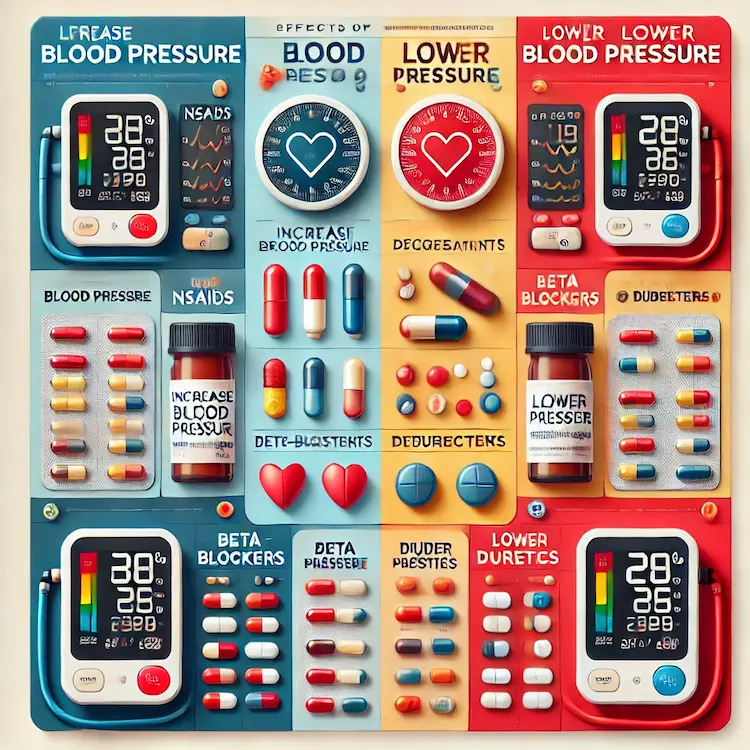Monitoring blood pressure is crucial for individuals taking medications that may affect cardiovascular health. Certain drugs can cause fluctuations in blood pressure, leading to potential health risks if not properly managed. Understanding the relationship between sphyg and Medication Side Effects on Blood Pressure Monitoring changes is essential for preventing complications such as hypertension, hypotension, and cardiovascular diseases.
This article provides a detailed guide on how to monitor blood pressure effectively while taking medications, discussing different tools, methods, and best practices for accurate tracking. We also explore the impact of medication-related blood pressure changes, relevant statistics, and expert recommendations.
Understanding Medication-Induced Blood Pressure Changes
Different types of medications can have varying effects on blood pressure. Some may cause spikes, while others can lead to dangerously low levels.
Common Medications That Affect Blood Pressure
Medications That Increase Blood Pressure:
- Nonsteroidal Anti-Inflammatory Drugs (NSAIDs): Ibuprofen and naproxen can cause sodium retention, leading to higher blood pressure.
- Decongestants: Pseudoephedrine and phenylephrine constrict blood vessels, raising blood pressure.
- Steroids: Corticosteroids such as prednisone can cause fluid retention, increasing blood pressure.
- Certain Antidepressants: Tricyclic antidepressants and serotonin-norepinephrine reuptake inhibitors (SNRIs) may elevate blood pressure.
- Hormonal Contraceptives: Birth control pills containing estrogen can raise blood pressure in some individuals.
Medications That Lower Blood Pressure:
- Diuretics: Help eliminate excess fluid and sodium, reducing blood pressure.
- Beta-Blockers: Reduce heart rate and cardiac output, leading to lower blood pressure.
- Calcium Channel Blockers: Prevent calcium from entering heart cells, relaxing blood vessels.
- ACE Inhibitors & ARBs: Help relax blood vessels by affecting hormone levels.

Why Monitoring Matters?
Ignoring blood pressure changes caused by medications can lead to serious health risks, including:
- Increased risk of stroke and heart attack from prolonged high blood pressure.
- Dizziness and fainting due to sudden drops in blood pressure.
- Kidney damage from uncontrolled hypertension or hypotension.
- Worsening of pre-existing conditions such as diabetes or heart disease.
How to Monitor Blood Pressure Effectively?
Choosing the Right Blood Pressure Monitor
A reliable sphygmomanometer (Sphyg) or digital blood pressure monitor is crucial for accurate readings. There are three main types:
| Type | Pros | Cons | Best for |
|---|---|---|---|
| Manual (Mercury/Sphygmomanometer) | Gold standard for accuracy | Requires training to use | Healthcare professionals |
| Digital Monitors | Easy to use, automated | May be less accurate if not used correctly | Home monitoring |
| Wrist Monitors | Portable and convenient | Less accurate than upper arm monitors | Travel & quick checks |
Best Practices for Accurate Readings
- Measure at the Same Time Daily: Blood pressure varies throughout the day; consistency improves accuracy.
- Sit and Relax for 5 Minutes: Avoid taking readings immediately after physical activity.
- Use the Correct Cuff Size: An ill-fitting cuff can lead to inaccurate readings.
- Keep Arm at Heart Level: Resting it on a flat surface improves accuracy.
- Avoid Caffeine, Smoking, or Alcohol Before Measurement: These substances can temporarily alter readings.
- Take Multiple Readings and Average Them: Single readings can be misleading.
Comparing Different Monitoring Approaches
| Approach | Advantages | Disadvantages |
|---|---|---|
| Self-Monitoring at Home | Convenient, tracks trends over time | Risk of improper technique |
| Clinical Monitoring | More accurate, performed by professionals | Requires appointments |
| Ambulatory Blood Pressure Monitoring (ABPM) | 24-hour continuous monitoring for better insights | Expensive, uncomfortable for some users |
Which Approach is Best?
- For daily tracking: Home monitoring is ideal.
- For in-depth analysis: Ambulatory BP monitoring provides detailed trends.
- For medical confirmation: Clinical monitoring remains the gold standard.
How to Manage Blood Pressure While on Medication?
- Consult Your Doctor Regularly: Adjust medication doses if needed.
- Maintain a Blood Pressure Log: Note readings, medications, and symptoms.
- Adopt a Healthy Diet: Reduce sodium, increase potassium-rich foods.
- Stay Hydrated: Dehydration can lower blood pressure too much.
- Exercise Regularly: Lowers stress and improves circulation.
- Monitor for Side Effects: Report unusual symptoms like dizziness or palpitations.
- Use Reminder Apps or Devices: Stay consistent with monitoring. Visualizing the Impact of Medication on Blood Pressure
A simple chart showcasing medication-induced BP changes:

Blood Pressure Fluctuations by Medication Type
| Medication Type | Effect on BP | Risk Level |
|---|---|---|
| NSAIDs | Increases BP | Moderate |
| Decongestants | Increases BP | High |
| Diuretics | Lowers BP | Moderate |
| Beta-Blockers | Lowers BP | Low |
| ACE Inhibitors | Lowers BP | Low |
Conclusion
Monitoring blood pressure while taking medication is essential for preventing serious health risks. Different medications can either raise or lower blood pressure, requiring regular tracking to maintain cardiovascular health. Using the right tools, following best practices, and consulting healthcare providers can help individuals effectively manage medication-related BP changes.
Key Takeaways
- Medications like NSAIDs and decongestants can raise blood pressure, while beta-blockers and diuretics lower it.
- Home blood pressure monitoring is convenient but must be done correctly.
- Clinical and ambulatory BP monitoring provide higher accuracy for medical analysis.
- Keeping a log of readings, symptoms, and medication intake is crucial for identifying patterns.
- Lifestyle changes, including diet and exercise, help stabilize medication-induced BP fluctuations.
Actionable Recommendations
Use an accurate digital blood pressure monitor with the correct cuff size.
Track BP daily and report significant changes to your doctor.
Avoid medications that spike blood pressure unless prescribed. Follow a heart-healthy diet rich in potassium and low in sodium.
Stay active and manage stress to improve overall medication Side effects and blood pressure monitoring.


